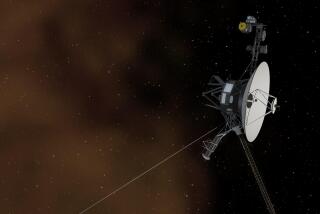‘Very Serious Anomaly’ as Mars Rover Clams Up
- Share via
NASA’s Spirit rover has stopped transmitting data back to Earth -- a development that Jet Propulsion Laboratory engineers described as a “very serious anomaly” possibly caused by a simple software glitch or a potentially fatal hardware malfunction.
Spirit, which had performed flawlessly since its Jan. 3 touchdown on Mars’ Gusev Crater, had sent back a beep Wednesday morning acknowledging that it had received a set of commands from mission controllers on Earth.
But the rover failed to return data about its overnight status that engineers had expected to receive.
Similarly, when the Mars Odyssey orbiter passed over the rover several hours later Wednesday, it was able to communicate briefly with the rover, but it too did not receive any data.
In essence, the orbiter received only “pseudo-noise,” consisting of random digital ones and zeros, indicating that the transmitter was working but that the on-board computer was not providing any information for it to transmit, said deputy mission manager Richard Cook.
The rover skipped two other opportunities for communicating with Earth before responding Thursday morning to JPL engineers in Pasadena, who were able to communicate briefly using the craft’s low-gain antenna. The craft automatically shifts to this antenna and transmits on a different radio frequency when its on-board sensors detect a problem.
The rover is also supposed to transmit the nature of the problem, but it has not yet done so, officials said.
Spirit’s communications breakdown sent engineers at JPL into a feverish search for answers. The rover team began examining failure scenarios for the craft without much success.
The team attempted to replicate the events leading up to the loss of communication by using a test rover in a Pasadena laboratory but were unsuccessful.
“There is no single fault that explains all these problems,” said project manager Peter C. Theisinger.
If the lack of data is caused by a software error -- which the team believes is the most probable source of the problem -- engineers are confident that they can rectify the matter and return the rover to normal operation, although the process may take several days.
Software or memory problems can be fixed with a software patch transmitted from Earth. Another possible solution is to simply reboot the rover’s computer, just as earthbound PC users often do when confronting a malfunction.
Team managers noted that similar problems had occurred with the previous Viking and Pathfinder missions to Mars and were corrected relatively quickly.
“If the problem is software or memory corruption and not a serious power fault, it can go for quite a long time and we can pick up the pieces again,” Theisinger said.
That the team had received even the brief communications from Spirit that lacked data indicated that there had been no catastrophic failure and thus appeared to support the theory that the rover was afflicted with a software gremlin of some sort.
If the problem ultimately proves to be something more serious, however, such as a hardware breakdown, it could jeopardize the mission of Spirit just before its twin, Opportunity, is scheduled to touch down on the Red Planet on Saturday.
“Something could break, something could fail,” Theisinger said, but the team has not observed any event on Earth or Mars that would correlate with such a failure.
Theisinger said that it was very unlikely that the problem was caused by any event on Mars. “I can’t conceive of a local environment problem that could cause this,” he said.
There have been no wind or dust storms at the landing site, and the Martian atmosphere is so thin that even a strong wind is unlikely to damage the craft.
At a Thursday morning news conference, Theisinger noted that “the rover is toward the end of its day on Mars and everyone here is very tired. We’re going to send everyone home to get some sleep” and then come back at it with fresh eyes.
The next opportunity to contact Spirit was scheduled for 3 a.m. today. “We can do a diagnostic and understand what happened, what are the corrective actions that need to be done, and how do we bring it carefully and thoughtfully to its normal operation mode,” JPL director Charles Elachi said in an interview televised by NASA.
“There is nothing rushing us to do the fix immediately, other than people being anxious,” he added.
Even if the team has not reestablished full communication with Spirit by the weekend, the shutdown will not interfere with the landing of Opportunity, Theisinger said.
That craft is expected to touch down in Meridiani Planum, on the opposite side of Mars from Gusev Crater, at 9:05 p.m. Saturday.
The team had initially thought that thunderstorms in Canberra, Australia, the base for Deep Space Network antennas -- used to contact the Spirit rover when Pasadena is on the side of the Earth facing away from Mars -- had created temporary communication difficulties by interfering with the command sent to the craft Wednesday morning. Subsequent events, however, indicated that the storms had no impact on communications with the craft.
More to Read
Sign up for Essential California
The most important California stories and recommendations in your inbox every morning.
You may occasionally receive promotional content from the Los Angeles Times.










